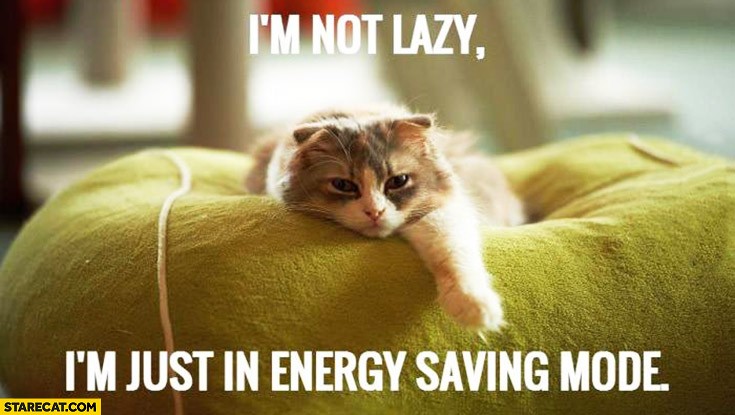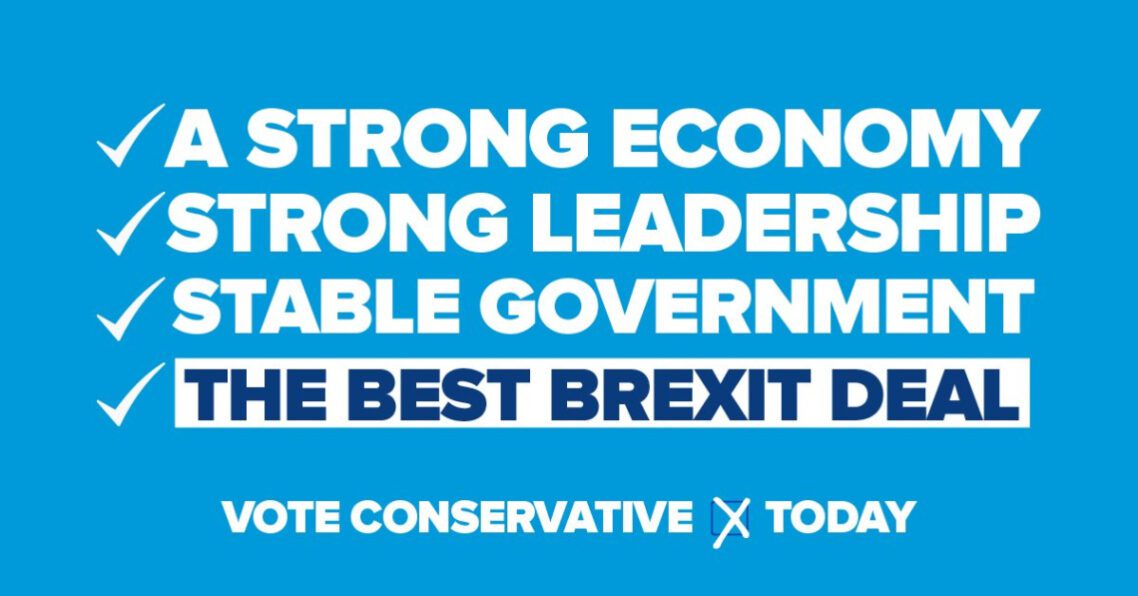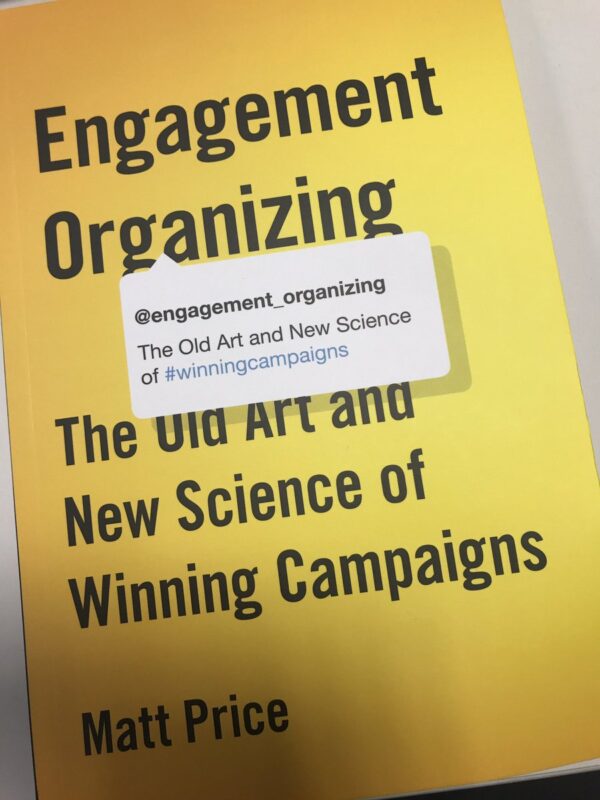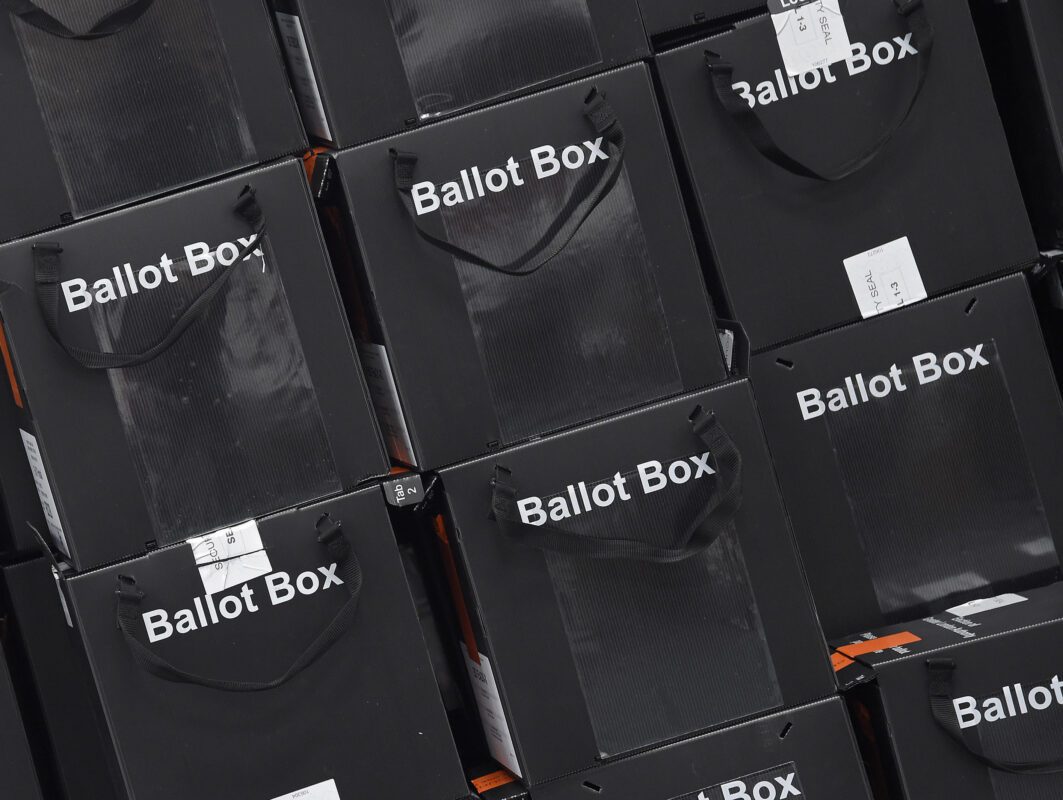After the last few years we’ve had, it seems foolish to make any predictions about what might happen in 2018. So as we start a new year for campaigning, I’ve decided not to make some predictions, but as I head back to work for the new yearm to make some suggestions of conversations that I hope we can have to make us more effective campaigners in the next 12 months.
1 – Are the tactics we’re using working? The end of the email your MP actions have long been predicted, with MPs repeatedly telling us that they don’ find them effective, and others using software to filter them out before they land in their inboxes. As the Social Change Agency have written recently ‘digital campaigning can feel a little stale’, while organisations like 38 Degrees are also looking to overhaul their tools that let you contact your MP. But as a few innovate out of the problem, the declining impact of these approaches impacts us all so I hope we can have a conversation about how we use digital tools to maximise their impact.
2 – Ask each other why aren’t we winning – Call me old-fashioned, but for me campaigning is about winning change. It means that I can get frustrated when I get a request to join a campaign where I can’t see how my action will contribute to the desired change. At the heart of good campaigning is a clear theory of change, which has had the assumptions challenged and stretched before a path of action is reached. With limited resources, we need robust theories of change to win, so in 2018 I hope we can go back to resources like Pathways for Change to make sure we’re asking difficult questions when we’re not winning.
3 – What does the changing media landscape mean for our campaigning? Nine of the top 20 news articles shared during the election were from non-traditional outlets, while a story on animal sentience became the most viral politics article of 2017, and was started on a small agricultural news website. More and more people are getting their news from hyper partisan sites, with content designed to be shared on social media, and with Facebook. If campaigning is about shaping a news agenda, how do we do that in what feels like an increasingly polarised and fragmented media landscape?
4 – Can we do more to share what’s working? I was really excited to see 38 Degrees publish a comprehensive study into their turnout campaigning they’d done around the General Election, and Engaging Networks have shared some useful benchmarks, and this is great by Forward Action. All examples of people sharing what’s working without needing to. But it feels like there is so much we could be doing, and in a more comprehensive way. I’m a member of the US based Analyst Institute which looks to share academic and practioner studies about what’s working, but that’s very focused on American electoral politics. So how do we encourage more of this among campaigners, including making our evaluations, including the not so good parts, more accessible and available to others?
5 – How to take GDPR seriously, but not become overwhelmed by it – As I wrote back in the summer, GDRP is coming and it’s something we do need to take seriously. Given the battering, the reputation of many charities have taken over the last few years, but I’m concerned that many of us will end up being paralysed by the regulation, some of the questions I’ve seen circulating on the ECF list indicate a nervousness about it. How do we make sure that we’re following the regulations, but also not further using this to hamper our effectiveness to campaign and mobilise our supporters who want to be engaged in our campaigns.
Category: learning
Help! I've got a new campaigning job, what should I do?
It’s a year since I started my role leading the Mobilisation Team at Save the Children UK, and over the last 12 months I’ve asked by others for advice about how to transition into well into a new campaigning job.
So I thought it might be useful to share a few reflections and lessons from what’s been a really exciting, varied and interesting 12 months, in the hope they might be useful for others moving into new advocacy and campaigning roles.
1 – Start by listening and then listening some more – The most useful book that I’ve found for thinking about the transition into a new role is ‘The First 90 Days’ by Michael Watkins. While the book is certainly focused on those making a transfer in the corporate world it’s a helpful primer for thinking.
And one of the things – they argue that too often new starters, especially new leaders or managers rush into a new role thinking they have all the answers, rather than actively listening to those they’re starting to working alongside or manage. The book encourages you to get comfortable with asking lots of listening conversations rather than feeling you need to contribute immediately without knowing the whole context.
2 – Plan to do your induction twice – thinking back to my first few weeks at the end of 2016, they were a bit of a whirlwind. Lots of short induction conversations, stacks of documents to read and the desire to be seen to be contributing to the organisation.
By Christmas, I was exhausted, so I found it really helpful to go back after the break with a plan to have a second round of induction meetings – creating a chance to ask some more questions, build better relationships with key colleagues and actually start to feel like I understood what was going on!
3 – What’s your ‘one or two big things’ – Sometimes the ‘one big thing’ is clearly set out for you by your new manager, but I found it really helpful to think about a small number of projects I wanted to get stuck into at the end of a phase of listening. It meant I could be focused, feel like I was contributing back to the organisation and having an impact. For example, one of the areas I wanted to focus on was increasing the variety of the campaign approaches we were using, as we’d become a little wedded to ‘email your MP actions’, the process of working with colleagues, and happily a year later we’ve done a real variety of actions which I’m really proud of the team making happen.
4 – Remember ‘culture eats strategy for breakfast’ – it’s one of those hideous management truisms that you see written on blogs like this from time to time, but it is in my experience true. So spending time understanding the culture of an organisation is so important. Obviously, you want to do a fair amount of that before you start in your new role, but so much of culture isn’t written down, so actively trying to understand it can really help to make sense of why decisions are being made. In saying this I’m not suggesting you have to completely accept the culture you encounter, sometimes things need to change, but understanding why things are approached in a particular way is an important first step.
5 – Keep outward focused – one of the first things that I found slipping out of my diary was external meetings or catch-ups with colleagues in similar roles across the sector. I soon came to appreciate that this wasn’t good move. It’s especially true in a big organisation where processes can consume lots of your time. If you’re someone who gets energy and ideas for seeing what others are doing make sure you protect that time and use it to bring new ideas to your organisation.
6 – Decide on your new habits and try to keep to them – Ahead of joining Bond back in 2014 I read Charles Duhigg book, ‘The Power of Habit’ and how new starts can be great opportunities to change your habits. For me that meant one area I thought a lot about was the management habits I wanted to employ, I took time to make sure I was clear on what I wanted them to be, and how I could go about creating habits that meant I stuck to them. I’ll be honest a few have fallen by the wayside, but many of them are now firmly embedded as habits. If you’d like to read more about leadership in campaigns, then this might be of interest.
7 – Write a ‘not to do yet’ list – I found in the first few month that it was easy to say ‘yes’ to everything, in part because I wanted to be seen to be doing a good job, but also because I had time and capacity because other projects were still taking off. It’s an easy temptation to get into, but a year later I’ve found having put together a ‘not to do yet’ list has been really helpful – for me it’s a list of projects or areas of work that I’m keen to get more involved in, but have held back from to ensure when I do I can do so confident in the capacity.
8 – Ask for feedback – One of the many things I really value about Save the Children is a culture of feedback. I’ve found it really useful to be able to get formal and informal feedback on what I’m doing, especially as I’m starting. I know it’s something that I still need to work on. And I know that some of my colleagues read this blog (hi!) so I hope they’ll be generous in providing feedback in the comments below or in-person if I’ve been inaccurate in what I’ve shared!
How to sustain the energy in your campaign
I’m off to chat to the good folk in the campaigns team at Battersea Dogs and Cats Home later today about how to keep the energy going in your campaign. It’s been a really fun question to be thinking about – not least because I can use a cute cat picture to illustrate this blog.
But as I’ve been preparing I’ve been struck that we often spend so much time and effort on planning the launch phase of our campaigns but don’t think about how to sustain the energy and momentum that we need to secure change.
As, George Lakey, said in his London lecture earlier this week, “a campaign, in contrast to a protest, is going at it over and over again, and escalating at the point of vulnerability of your target until you succeed”.
So here are 9 thoughts about sustaining the energy in your campaign;
- Think about the moments that people care about not moments you care about – too often we focus our campaigning around pushes that fit our policy calendars. There can be a rationale to that, but why not look at alternative moments that might help to get your campaign noticed in an a different light.
- Mind the moment gap – thinking about moments means that we can get caught forgetting what’s going to happen in the gaps. It’s hard to sustain the same level of output for a long period of time, but planning ahead and thinking about how well placed media work, a opinion poll or another approach.
- Ask what’s working/what’s needed – if you have allies inside your target, why not ask them what’s working or not working. What tactic could help to make the biggest different at that moment. They might make suggestions that you’ve not thought about or how to open up a new flank in your campaign.
- Share, and re-share, great content – shareable content is king, but too often we produce it without thinking about audience insight, or rush to move onto the next great idea without pushing it out enough. In a time when we’re bombarding by so much content, repackaging and reusing content is too often overlooked. The same goes for message discipline, I’m struck by how much time Shelter put into repackaging the same message in their housing campaigns.
- Never let a good crisis go to waste – it can be easy to see crisis as moments that you can’t plan for, but I’m not sure that’s true. Most crisis can be anticipated even if the exact timing can’t be pinned down. They’re great opportunities to reach new audiences or create a renewed push behind your policy ask. I thought Which? did this brilliantly around the RyanAir flight cancellations recently – they presumably know that a crisis was going to occur and had the content ready for it. What’s the equivalent for your campaign issue?
- Explore allies and alliances – bring in new people to your issue by thinking about how you can take it too new audiences. Too many campaigns try to focus on energising the same group of people to get involved over and over again, but those that are able to reach out to new groups can immediately bring in new energy.
- Claim it – Campaigns with big ambitions can sometimes lose energy and momentum, but like your teacher would have advised you when planning your revision timetable, it’s easier to eat a chocolate elephant a little at a time.
Breaking down your campaign and building in winnable milestones can really help. We’re running a campaign on the conflict in Yemen at work at the moment. It’s a big problem to solve but by focusing our campaigning on milestones, like getting the UN to list the Saudi led coalition in a key report, has helped to provide milestone win to keep supporters feeling like the actions they are taking are making a difference. - Give it away – provide campaigners with the tools and content to make their own and get out into their communities – it’s a key approach that many distributed campaigns take, allowing the energy and ideas of those closest to a community to engage in a campaign.
- Abeyance – while many campaigns are right to keep going, sometime a period of abeyance can be the best approach, a period when a campaign isn’t in public view. We perhaps sometimes forget that it took over 100 years for the campaign to end the Slave Trade to be successful.
What other ideas and lessons do you have about how campaigns can sustain the energy needed to win?
Inside a failing campaign – lessons from the Conservative 2017 election effort
Regular readers will know that I believe you can learn as much from an unsuccessful campaign and you can from a successful one.
Conservative Home editor, Mark Wallace, publishes a three part insider look at why the Conservative campaign failed at the General Election (part 1, part 2 and part 3). It’s a really great set of articles which gets under the bonnet of what did and didn’t work at an operational level – rather than too many post-elections which focus on the personality clashes between competing politicians. As an aside, I’d also recommend Mark’s writing on the referendum campaigns.
Although the articles are written with the intention of trying to change practice in the Conservative Party going forward, there are a number of lessons that I think can be applied whatever issue your working on. I’d strongly recommend that you read at least the first two articles, but here are the takeaway lessons that I’ve taken from the articles;
1 – You can’t fatten a pig on market day – the famous saying of Conservative election guru, Lynton Crosby, as a reminder that successful campaigns take months, sometimes years of meticulous planning. That it takes time to have the right staffing infrastructure in place, message testing done and materials ready to go. It really is a process you can’t rush.
2 – Get the right people on the bus – successful campaigns need the right people, with the right experience, making decisions at the heart of them. Wallace’s articles include numerous about the lack of clarity in decision making, too many people involved at the tops and the fact that many experienced staff had been let go after the 2015 election. You need to have the right skills and experience to win.
3 – Practice open loop listening – Conservative activists on the ground were repeatedly finding that the data selections that they were being given we’re missing often known Conservative voters, but despite feeding that upwards the data selection stayed the same. Those at the center of the campaigns were so sure that their models were correct the ignored what those on the ground were telling them, a classic example of closed loop learning.
4 – Data deteriorates fast – at the end of the 2015 General Election, the Conservatives had over 1.4 millions usable email addresses, but fast forward just 24 months, and the articles suggest that up to much of this data was out of date (as a reference between the 2010 election, when they had collected 500,000, and 2013 when they started planning for 2015, the list had shrunk to 300,000). A reminder that any campaigning organisation needs to be proactive at continuing to collect data.
5 – Distributed v’s Centralised – the campaign was heavily centralised, with a focus on a few core messages – remember ‘Thresea May’s Conservative Party’ and ‘Strong and Stable Leadership’. This meant there was little space in literature for candidates, who often have a much better sense of what messages would work in a community. That lead to big errors, for example literature featuring quotes from The Sun being sent to seats in and around Merseyside where their is a significant anti Sun feeling, but the same approach surely meant the Conservatives missed opportunities for picking up effective local campaign led by candidates. As a contrast, Ben Pringle has some reflections on how localised campaigns helped the Labour Party
6 – If it ain’t broke don’t change it – Following the 2015 General Election, the Conservatives had found a number of effective approaches working both in individuals constituencies, and how to make the most of working with activists. But many of those approaches were thrown out for 2017. Sure innovation and changing approaches is important, but not at the cost of the basics that have been proven to work.
7 – Message amplification – Wallace reflects on the role that a range of third party organisations and individuals were active at amplifying the messages coming from the Labour Party – the micro-PAC phenomena I’d highlighted in this post – while the same didn’t happen for the Conservatives. A good reminder that the reach of your own social channels, however large, can only get you so far, and you need to build a wider network of support. See more on this over at Political Advertising.
8 – Don’t forget to say thank you – Imagine you’ve just put your life on hold for 8 weeks to run to be a candidate, you’d expect in the days or weeks after election night that you’d get a personal thank you for those who’ve lead the campaign. That didn’t happen for most Conservative candidates, they got a generic email, sent to thousands of other helpers, and that was about it. Not good for motivation!
If you’ve read the articles, what other lessons are you taking from them?
What stops us embracing an organising approach?
A colleague in some recent handover notes wrote ‘while we talk a good game on organizing, we’re still really focused on mobilising’, or something to that effect. It’s a very fair challenge and one that I’ve been reflecting on since reading it.
Like many in the campaigning sector, I’ve got really excited about the opportunities that an organising approach to campaigning brings – not least because I’ve been inspired by the campaigns that are using it and winning, but the day to day model of campaigning that I’m most accustomed to is a mobilising one, and getting from one approach to another isn’t easy.
So I was really excited to get a copy of Matt Price’s new book ‘Engagement Organizing – The Old and New Science of Winning Campaigns‘ at the start of the month. I’d met Matt at the MobLab Campaign Con in Spain last autumn, and read some of his online articles looking at campaigning approaches in Canada.
Matt is based in Vancouver, so the case studies are drawn from NGO, Union and Party Political campaigns that are north of the 49th parallel. We might look across the Atlantic to the US for most of our inspiration, but the reality is that the similarities in political systems in Canada mean we’ve probably got as much to learn for our campaigners, and it was really nice to read some case studies of campaigns and organisations I wasn’t so familiar with.
But what I really like about the book is that it’s a practical how-to guide, that looks to blend together how campaigners can draw on the best of the digital. Instead of trying to push a particular organising perspective, or suggest that everything can be won by smart digital campaigning, the book explores how to blend these approaches together for maximum impact.
Lots in Matt’s book resonates, especially the chapter on the Engagement Cycle, as opposed to the more traditional pyramid of engagement, and also the stories of the approach of Cesar Chavez and the United Farm Workers in using house meetings as an organising approach.
At the end of the book, Price offers some reflections and challenges that prevent NGOs from embracing this approach. They got me thinking back to the challenge from my colleague, and if they’re true in the campaigning that I’m doing;
1. The work is hard – Price writes about the challenge of ‘organizers entropy’ suggesting there isn’t always enough energy in the system to do useful work. That means that organisers need to keep bringing energy into a system, and that often a win can take energy away as those you’ve organised feel that their goal has been achieved. That resonated – moving to an organising approach means keeping moving away from the norm. It’s learning a new memory muscle, and that can be exhausting. As a campaigner, I need to keep bringing energy into the system, and to those pushing this work forward.
2. Resources – while the ‘snowflake model’ shows that you can build an approach at scale with volunteers, and digital tools have lowered the costs for campaigning, Price points out that even then organising at scale costs money. Something that can be especially challenging in organisation where you need to continue to demonstrate impact and value for money. Again this feels very relevant – how do I resource the slow but important work of taking an organising approach, when the mobilising approach can demonstrate ‘quick wins’.
3. We don’t review our ‘stop doing’ lists – rather than a ‘to do’ list, Price suggests we need to ask some hard questions of what we’re already doing, and ask if they’re the most important things we can be doing to ensure we’re effectively using time and resources. It’s a really neat idea, and Price has some helpful questions to ask to help do it;
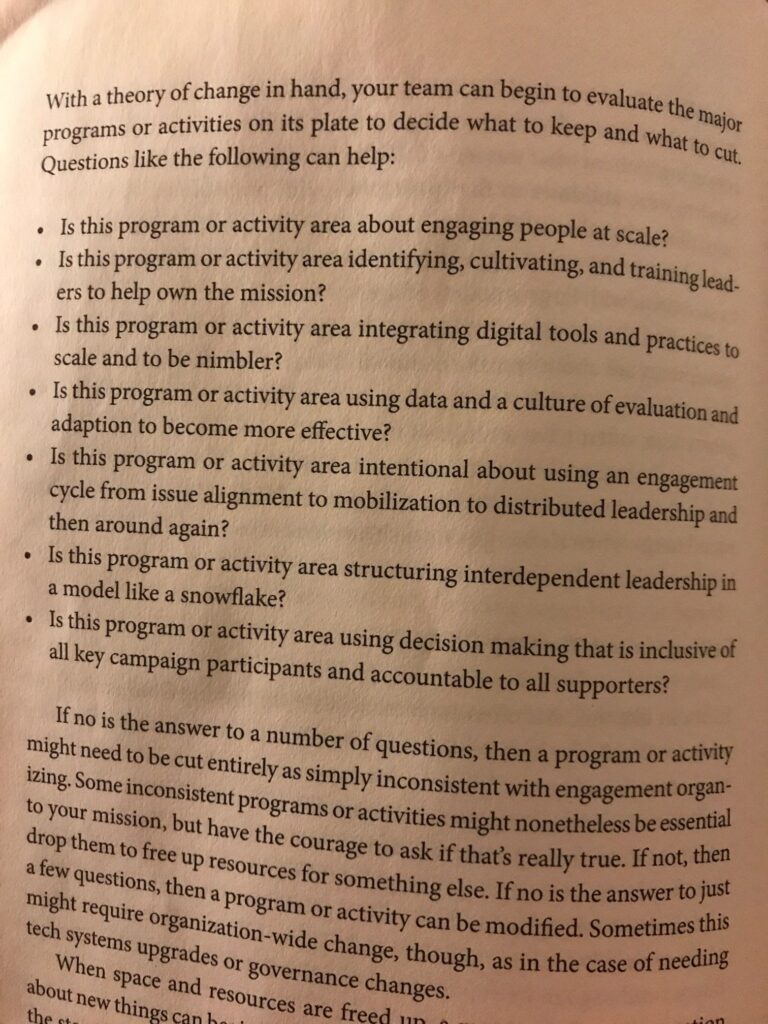
4. Overcoming organisational inertia – Linked to the work is hard, is the challenges we can face within our organisations with systems, practices, and cultures that are hard to change. Some of that comes from the experiences, practices, and expectations of those who’ve risen to more senior roles who’s campaigning was shaped in a more broadcast era (I count myself in this), some of it is about the systems we use which aren’t built, while culture is often seen as the ‘way we’ve always done things’ and is hard to shift. I’m not sure I have any simple solutions to this, but it’s something I’d like to reflect upon in future posts.
5. We need to talk about power – One of my reflections from time spent with Hahrie Han last year is that an organising approach requires us to have more conversations about power – its something that came through again reading the book. Both about how we give it away, alongside control to those we’re seeking to empower, but also how we ensure we’re directing our campaigns to focus on where the power is. As Han says ‘movements build power not by selling people products they already want but instead by transforming what people think is possible’.
I’d recommend Matt’s book for anyone interested in how to embrace a more organising approach in their campaigning.
What campaigners can learn from Chris Froome
I’ve been fascinated by politics and campaigns from a young age, but my parent have evidence that I’ve been making Tour de France scrapbooks to follow the annual cycling race since I was 10!
So as Chris Froome wins his 4th Tour de France, I’ve been thinking a little about what lessons campaigners can draw from cycling, and in particular Team Sky (who’ve won 5 of the last 6 races) when it comes to strategy, approach and execution.
1 – Be totally focused on winning – Team Sky come to the Tour de France with one clear objective each year – to win the race. Throughout the 3 weeks that the race moves around France, there are plenty of other sub-objectives to distract – you can win stages, win other jerseys, and more. But Team Sky don’t get distracted by them – they just care about getting their leader across the line in Paris at the end of the race. It’s a ruthless focus on a single goal.
2 – Adjust your plans daily – The old adage that ‘no plan survives first contact with the enemy’ is true in the Tour. There are so many factors the can’t be immediately planned for or predicted – the weather, someone on the team might be injured and not able to race or a mechanical problem. Anticipating what might happen, and then adjusting has been evident throughout the race, when Froome got a puncture, the team member riding alongside him was ready to sacrifice his wheel, while others were ready to pace him back to the front. And because the team have a clear objective, they know what the implications of adjusting the plans are.
3 – Poor planning leads to poor performance – Let me take you to Rodez and the end of stage 14. Chris Froome has lost the Yellow Jersey (worn by the leader of the race) to Italian Fabio Aru, but his team have spotted that the finishing line is uphill and could allow Froome to get some time back on Aru. So the team ride the whole day with the objective of getting Froome to the foot of the climb at the front of the field. Aru’s team don’t and he loses the jersey.
Other examples abound, from having support staff down the narrow roads of the French countryside to give out bottles and musettes (the bags with the cyclist food) rather than rely on going back to the support cars, to exploiting the changing direction of the wind on stage 16 to break the field into a smaller group, to having mechanics double-check everything on the final Time Trial stage because Froome couldn’t afford a mechanical mistake. Team Sky don’t let anything get past them when it comes to being brilliantly prepared. It’s a good reminder for campaigners to apply the same approach.
4- Marginal Gains – Team Sky are built on the concept of marginal gains – the idea that you should be looking for ‘the 1 percent margin for improvement in everything you do’. It’s about being data driven and question everything + challenge existing assumptions. Earlier this year I read ‘The Talent Lab‘ which looks at the approach of the British Olympic team, which shares many of the same approaches as Team Sky.
When members of British Cycling, who work closely with Team Sky, identified that they could improve the power output of there cyclists by making small adjustments to the saddle angles they lobbied for the rules to be changed. Nothing is left to chance when it comes to the approach they’re taking, but perhaps more importantly no question or assumption is a dumb one to asks. For campaigners I think it’s a reminder to look for improvement in every area, but also have a really questioning mindset.
5 – It’s a team effort – Sure it was Chris Froome standing on the top step of the podium in Paris, but he’ll be the first to tell you that he couldn’t have achieved it without the 8 other members of his team. Everyone in the team has a clear role to play across the range and through each stage. Some to support on the flat, some when the race goes up hill. In some way cycling is the ultimate team sport. It reminds me of this list of roles needed in an advocacy movement. You often need all of those roles to be successful.
'Mistakes, I've made a few'
‘Mistakes, I’ve made a few’ so goes the song. I’ve been thinking a lot about how I can learn from mistakes and failure since the start of the year. Much of it was prompted by reading Matthew Syed’s Black Box Thinking. In it, he writes
‘a closed loop is where failure doesn’t lead to progress because information on errors and weaknesses is misinterpreted or ignored; an open loop does lead to progress because the feedback is rationally acted upon’
The book explores why some industries, like airlines, are good at practising open loop learning, while others, like the medical profession, less so – see here for the obligatory Ted Talk to accompany the book.
I’ve been thinking a lot recently about how I can get better at learning ‘open loop lessons’ in my work. Many of the campaigning organisations that I admire at the moment talk about how they have a culture of testing, and a high tolerance for failure, so what can I do to encourage that where I’m working?
It was something I challenged others at ECF to do (and it’s something I’ve blogged about before), so informed by a Chatham House rules session at ECF back in April, and my own reflections on when I’ve not got things right, here are a few reflections on how projects that I’ve been involved in don’t always work out the way they should.
1. The internal excitement bubble – sure they say in a brainstorm that ‘no idea is a bad idea’ but if you’re going to invest significant resources in taking an idea to market, it can pay to do some insight work first. To check that when you take your idea out of your organisational bubble it still a great idea. I remember the campaign I was involved in when we were sure people would want to stick around and ‘make a weekend’ of the march, so we invested in a range of events. Hardly anyone came along. Something we would have found out if we’d asked a few people about their plans. Great idea in our bubble, less so outside of it!
2. Going to scale too quickly – sometimes good ideas need to take time to grow, you need to start small to learn what’s really going to work and what’s not going to work before you go to scale. I know that I’ve fallen into the trap of believing that we can quickly grow a scheme or idea, but in the attempt lose a huge amount of the goodwill you need for a project to succeed. I can vividly recall one volunteer project when we came up with an elaborate plan involving, but soon found it wasn’t working. A quick pilot of a few months would have easily helped us to iron out the kinks in it, but instead, we squandered a huge amount of goodwill.
3. Less failing, more fizzling out – Perhaps this shouldn’t be talked about in a post on failure, because much of our focus on the failure of a project or idea to get off the ground. But the truth can be that sometimes not knowing when to end something is as much a failure as not getting something started. I can think of a number of projects that we should have closed down rather than just keeping them going with just enough resources to stay afloat but not enough to have the real impact they should.
4. The resource gap – I know I’m guilty of this, especially as a manager where it always feels like you’ve got to make a trade-off between the amount that you can resource a project. But not backing a project with the resource it needs, or worse still ignoring what experienced colleagues are saying about the resourcing needs, in the hope that by sheer determination you can get it over the line.
5. Who wants a project to succeed? – Successful projects need clear owners. I’ve seen many projects squander because they lack someone who feels responsible for delivering. This is especially easy in a big organisation where. Since starting in my new role at Save the Children I’ve really found using a R.A.C.I. to be a useful tool. They help to ensure everyone is clear on who is responsible (the person who is going to make it happen) and accountable (the person who needs to be held to account if doesn’t happen). How I’d wish been introduced to that earlier in my career.
6. A Fresh Pair of Eyes – We’ve all done it, sent an email out with a terrible typo in the subject line, forgotten to add the link in or accidentally over promoted someone in an email. Lots of the mistakes I make are because I’m too close to the topic and thus blinkered to the details. A fresh pair of eyes is what’s needed. But as Jim Coe writes in this post on why we missed the election outcome, the concept could be used more widely, by making sure that we’re involving a wide range of perspectives and approaches, to challenge what might be in front of us but we can’t see because we’re blinded by certainty.
I’m certainly on a journey on all of this, so I’d love any reflections that readers have about how as campaigners we can get better at open loop learning.
Before the results – some observations from the 2017 General Election
I love elections.
While I might have complained when I first heard that Theresa May was taking the country to the polls, it wasn’t long before I found myself getting stuck in campaigning in my local community, and implementing our (hastily assembled) election plans at work.
Who knows what will happen on Thursday evening, but before the results come I wanted to highlight a few ‘winners’ from the election, based on the campaigns that I’ve noticed.
1. The rise of the MicroPACs – BBC News has this great article on the rise of individuals who’ve used Facebook and other social media platforms to get their campaign messages out, what they’re dubbing MicroPACs – after the Political Action Committees that pour huge amounts of money into campaigns in the US. While much of the campaign news has focused on the huge ad spends of the Conservative Party on Facebook advertising, learning from what Trump did in the US which is summarised well here.It’s fascinating to see how individuals with some expertise of how to do effective targeting, and effective messages can get them out in front of tens of thousands of people.
Certainly a lesson to be learnt here for all campaigning organisations about how giving away some control of your message can lead to creative execution of ideas. Having said that the work that the team behind Who Targets Me has been doing is also fascinating work tracking the adverts that the parties are pushing – this article gives a small snapshot in the breadth of messaging targeting.
2. 38 Degrees and Avaaz dive right in – Unlike 2015 when it felt that both of the big online platforms seemed to be less involved, both Avaaz and 38 Degrees have been really active in this election. Perhaps been learning from colleagues at Get Up in Australia who’ve built themselves in formidable election campaigning machine.
While 38 Degrees have been focusing on voter turnout in two marginal seats (Hove and Bath) looking to encourage civic participation rather than pushing a specific party, as well as organising a hustings. Avaaz have been much more active at pushing supporters to join activities of progressive parties, and supporting the work of the Progressive Alliance (see below).
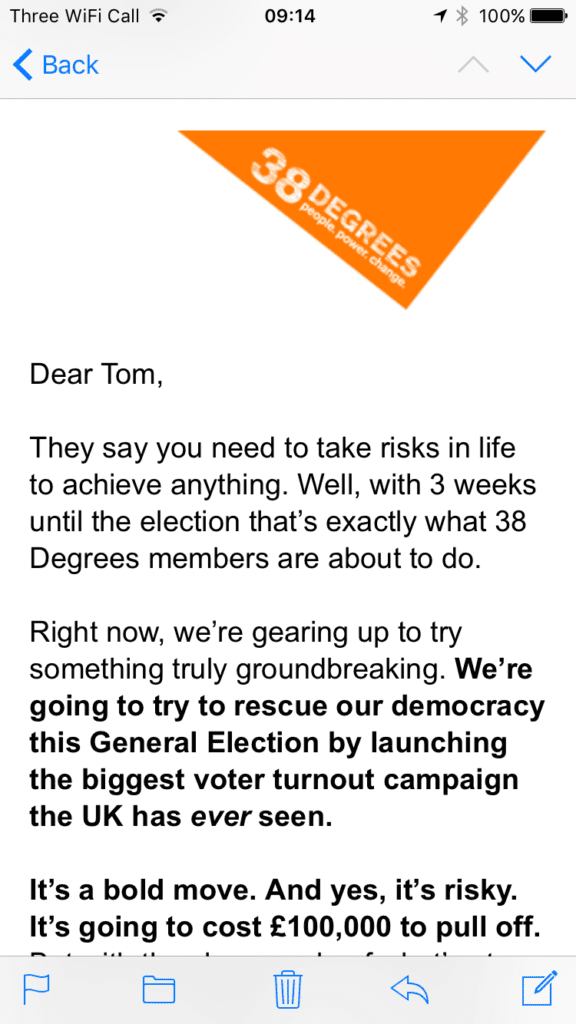
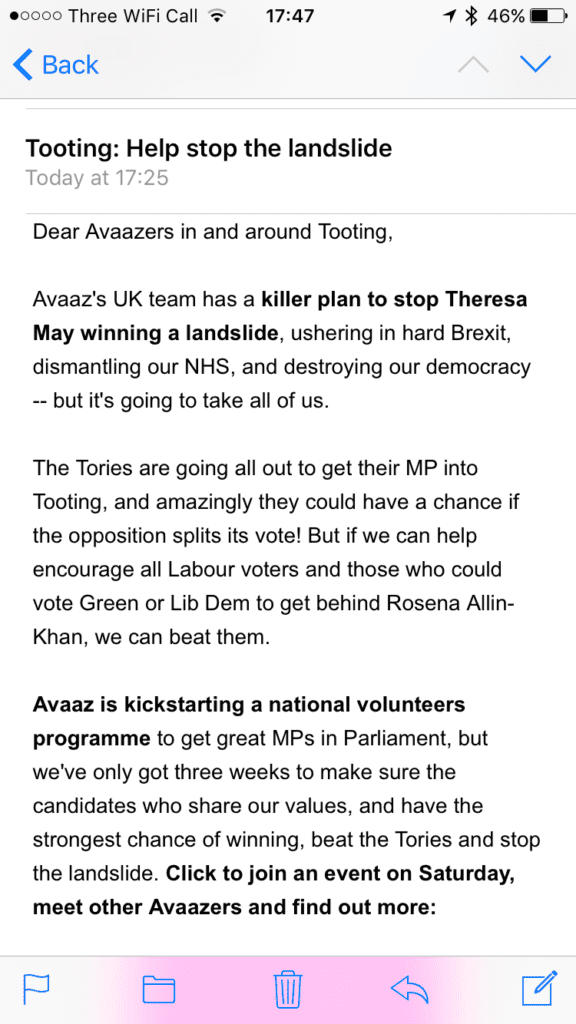
It’s also been interesting to see a few other initiatives emerge during the election, including More United, which was is campaigning for pro-Remain candidates, and Campaign Together, which has been driven by some campaigners involved in the Bernie Sanders campaign. I’m sure post-election there will be time for those involved in some of these initiatives to share the stories of what worked and didn’t work, hopefully providing some useful lessons for campaigners on new models of organising.
3. Go local – I’ve long been impressed by the School Cuts campaign run by the NUT but they seemed to have kicked it up another level this election. The website has been updated to show the impact of proposed party manifestos from each party, coordinate local groups – I’ve seen an increasingly active local campaign in Tooting where I live, and some cracking social content which has clearly tapped into parents concerns. Some really useful lessons in this for all campaigners, including about the importance of providing local information if you can to help make your campaign as tangible as possible to people.
4. The Lobbying Act – despite renewed assurances from NCVO and even the Electoral Commission that charities can campaign, the act seems to have had the anticipated ‘chilling effect’ on many charities (see here as a good example of concerns). Perhaps it was the short notice of the campaign that meant unlike 2015 organisations didn’t have time to prepare, but the act has once again appeared to have an impact on the way that many charities have engaged in the election. Following the election, campaigners need to look again at how we can get the Act amended to remove any ambiguity about charities campaigning during elections.
5. Aid Campaigners – so I’m biased, and can’t share everything that happened, but the first few days of the election saw a huge amount of focus on if the Prime Minister would commit to maintaining the 0.7% aid target. It was a heavy lift, but within a few days we’d seen all parties commit to the target. It happened through a combination of bringing smart insider engagement with key influences together with targeted public pressure demonstrating the depth of support for the issue, and developing messaging we felt would resonate beyond our traditional supporters (see #BiggerBritain). It was lesson for me of the importance of how all the aspects of advocacy can complement each other, and how to use different tactics to drive the issue across news cycles. I’ll write more in due course!
And finally, NCVO has also come up with a neat list of 10 great charity campaigns this election – it’s full of more good ideas of how charities can make the most of an election.
Leadership in campaigns – links for Sheila McKechnie Foundation 'Masterclass'
I was invited to speak today at a Sheila McKechnie Foundation ‘Masterclass’ on leadership in campaigns – mobilising internally and externally. It was a fun session sharing alongside Claire Hazelgrove from Friends of the Earth, and a group of 20 or so campaign leaders from across the campaigning community in the UK.
We looked at what it means to lead internally within our organisation and externally in coalitions. I draw on a few themes that I’ve written about before on this blog, but wanted to pull together some of the resources I mentioned during the session, both for those who came along (thanks for joining) and others who might be interested.
Leading Internally
- When it comes to leading others, it’s really helpful to take the time to consider your leadership style. Tools like Strengthfinder, Myers-Briggs, or www.16personalities.com can be helpful for thinking about this, and then having a conversation as a team or with who manage you.
- I’ve found the writing of Margaret Wheatley, who wrote this excellent and very accessible paper (it’s only 6 pages long) on ‘host leadership’ a few years ago excellent and speaks to some of the differences of leading campaigners.
- These are a few more of my thoughts about leading campaign, and the importance of making sense of the story for those your leading, and the need to continue to share your theory of change.
- I’d encourage any campaign leader to create space to be curious. Some of my thinking has been drawn from the work of Duncan Green and idea of dancing with the system, see my post here on his ideas, and a link to his book ‘How Change Happens‘. I’d also really recommend this by Kate Norgrove who has just finished as Head of Campaigns at Water Aid asking how we know if we’ve made a difference.
- This is more about the DARCI tool that Claire shared.
- When it comes to leading ourselves, I’ve spotted a few people sharing www.findingsteadyground.com in the last few weeks, this is timeless advice and plantothrive.net.au is a good set of resources from Australia.
Leading Externally
- I always point people to this long read from Brendon Cox from a few years ago is an authoritative look at what makes a coalition work.
- A few of my thoughts about what makes coalitions work are here, while this is about the costs of working in coalition. Headlines are they require work, build trust, find the coalition builders and know when to end it.
- I really enjoyed the discussion about how we maintain hope in difficult times. If you’ve not watched Selma, Pride, Milk, Cry Freedom or the many other great films on campaigning then do (this list has some other ideas), and I think it’s prompted me writing another post about the leaders behind the leaders of great campaign movements. As Claire reminded us we should never forget these words of Martin Luther King
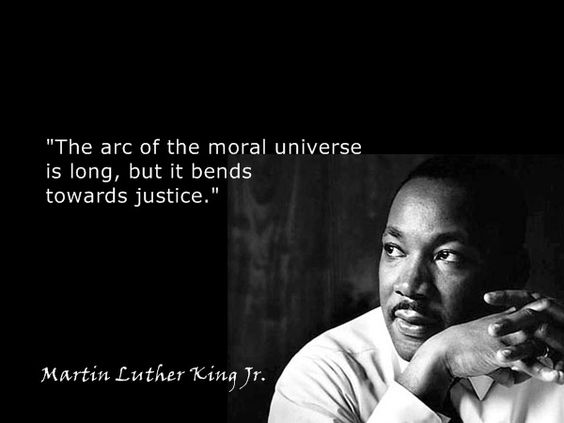
- On how our tactics need to respond to the times we find ourselves in. I’d recommend a read of Micah White’s ‘End of Protest‘ not an easy read but a really interesting one.
Why it's time for campaigners to take digital security seriously…
While my password is more sophisticated than ‘password’ – you might laugh but a recent article by suggested that’s a very common password – I know I’ve not spent enough time thinking about protecting myself online.
But with news of the hacking of the Clinton campaign, an awareness of how much information that I produce is held in ‘the cloud’, and reading stories like this about a sophisticated attempt to create a fake campaign group to hack the IT systems of organisations like Amnesty who had been raising concerns about workers rights in Qatar. I’ve started to think that I need to consider taking my digital more security more seriously.
As campaigners, we’re often working on issues where there are powerful vested interests that we’re opposing, so making sure that we’re thinking about our data security should be on our to do list. Attending CampaignCon in October it was interesting just how many campaigners at the conference were talking about it as a key concern for the work they’re doing.
For many campaigners, it’s a challenge to get the balance right. We want to collaborate with others which makes platforms like Dropbox and Google Doc invaluable, we need to use social media channels like Twitter and Facebook to get our messages out, and investing in complex cyber security can feel like an unnecessary cost when every penny counts..
It’s easy to think that you only have to worry about your digital security if you’re running some campaign on the arms trade, or in a country with a repressive government. But that’s before you start to investigate the powers that governments have over our data (see the recent Investigatory Powers Bill/Snoopers Charter passed in the UK last) or consider what new laws President Trump might implement and what that would mean for any data held in the ‘cloud’ on a US server.
2017 is the year that cyber and data security need to be every campaigners concern.
If that’s not enough to convince you – at a time when elements of the media are looking for charity scandals making sure that you’re no unwittingly writing a front page story is another reason to revisit those social media permissions.
I’m no expert at how to do this, but I’ve found the following articles really helpful as an introduction to thinking about digital security – but please do add other thoughts in the comment box below.
Step 1 – Start with some light housekeeping – I found this article from Owen Barder really helpful. It’s nothing complicated, but making sure that you’ve got two-step authentication set up, are using a password manager and thinking about where you store key information are some simple and easy steps to take.
Step 2 – Think about encryption – This is a really helpful guide to thinking about how you can tread more lightly when you’re using the internet. Again, nothing that requires lots of technical expertise, but it’s got some really useful suggestions about how to search in private or use secure message platforms like Signal to share.
Step 3 – Consider a digital detox – If you’re concerned about Google actually knowing more about you that your best friend thanks to your search history, use of Google Maps, etc. Have a look at the Digital Detox that Tactical Tech have launched. Again its’s full of really simple and easy steps you can take to take back control of your digital self
Step 4 – Review your campaigns risk – Clearly every campaign comes with a different level of risk attached to it, but this articles from Mobilisation Lab really helpful. I found thinking about this made me consider what information I’m sharing information with on email or who is on those big mailing lists I’m sharing my latest campaign dilemmas with.
Step 5 – Dive in to find out more – The Tactical Tech Collective is a brilliant place for anyone wanting to learn more about digital security – there Security in a Box project while designed for frontline human rights defenders has lots of practical ideas.
Please do use the comments box to share others thoughts, ideas and resources.


